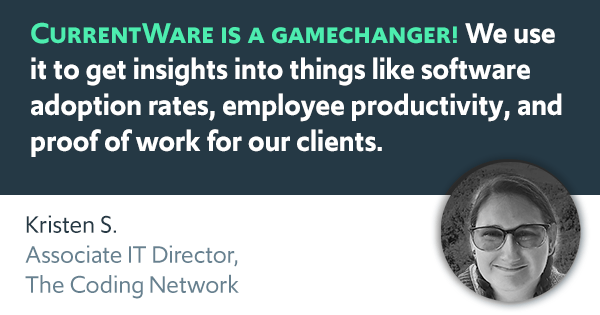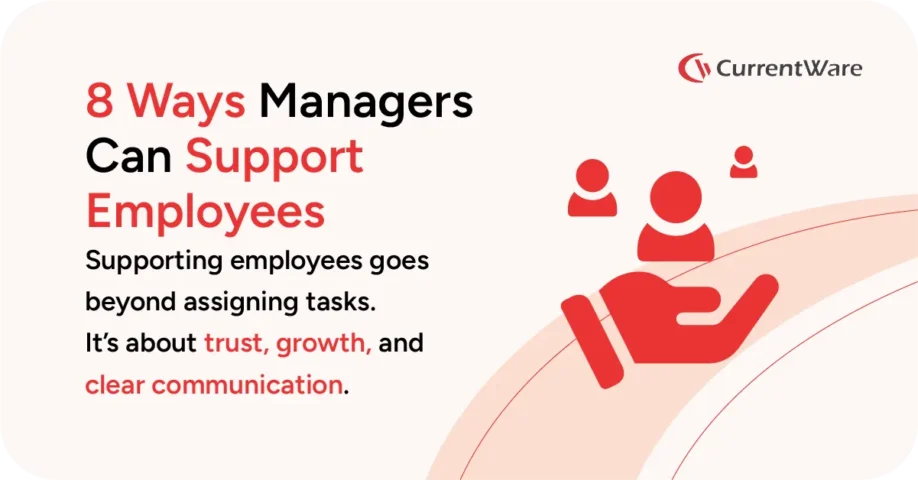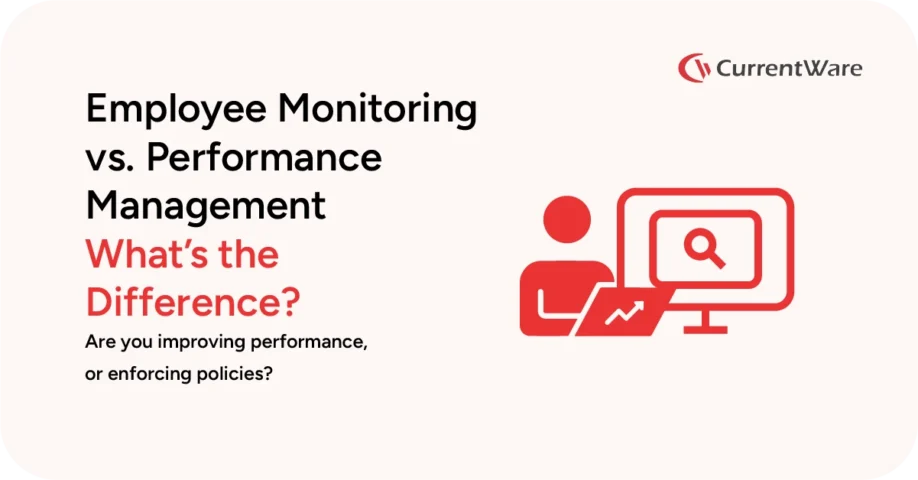70+ Employee Monitoring Statistics Companies Need to Know
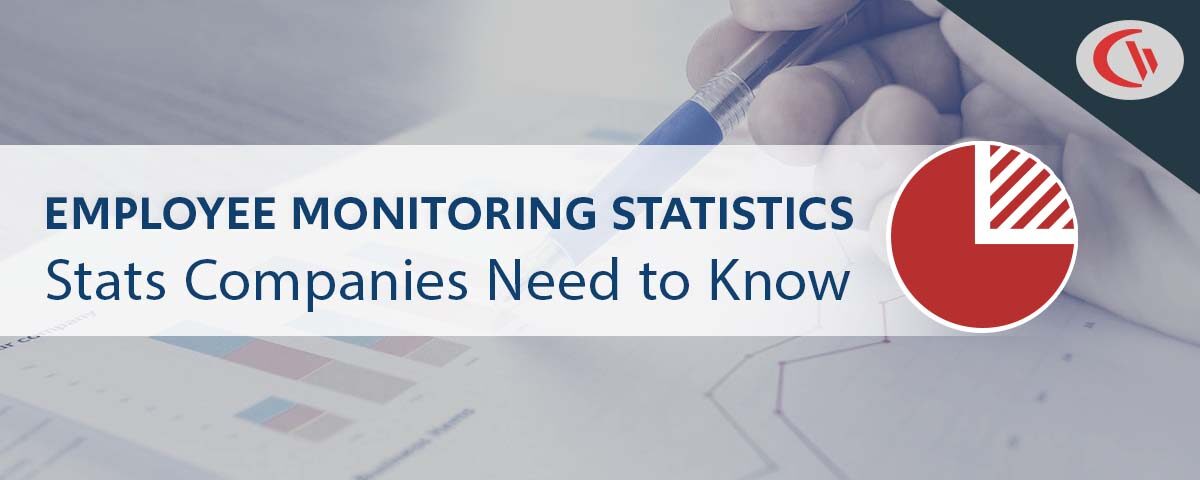
Considering monitoring employees in the workplace? These employee monitoring statistics provide an overview of how popular employee monitoring is, the data that companies collect, and why employers monitor their employees.
Further Reading:
- What is Employee Monitoring?
- Pros and Cons of Employee Monitoring
- Best Practices for Monitoring Employees
- How to Monitor Employees Working From Home
- 40+ Terrifying Cybersecurity Statistics You Need to Know
- Internet Usage Statistics
Top 5 Employee Monitoring Statistics of 2025
- By 2025, it is estimated that 70% of large employers will monitor their employees (Gartner)
- 1 in 3 employees have used their work computer for purposes that they’d find embarrassing should their employer find out (ExpressVPN Survey)
- When a group of Canadian employees were asked by Capterra what the benefits of employee monitoring was:
- 39% said it gave their employers more insight into daily business operations
- 38% said it can ensure staff are never underpaid
- 37% said it allowed mistakes to be caught before they can escalate
- 35% said it gave employers greater visibility into high and low work performers
- 34% said it allowed employers to help them work more efficiently during work hours
- 60% of companies with employees who work remotely are using monitoring software to track employee productivity and activity. Another 17% are considering it.(Digital.com Survey)
- 92% of workers are open to the collection of data on them and their work, but only if it improves their performance or well-being or provides other personal benefits (Accenture Survey of C-suite Executives)
How Common is Employee Monitoring?
“No matter how you feel about it, employers that don’t monitor will become fewer and fewer, not to nail employees, but because monitoring increasingly makes business sense.”
Manny Avramidis, president and CEO, the American Management Association
Digital forms of employee monitoring accelerated significantly during the COVID-19 pandemic, alongside the rise in remote work. For managers of newly remote teams the use of a remote employee monitoring program has been essential to ensure workplace productivity and data security while their employees work from home.
Companies offering workplace surveillance technologies such as CurrentWare have experienced a sustained surge in demand from employers through the pandemic. CurrentWare alone saw a 130% increase in queries for our employee monitoring software during Q1/Q2 2020.
| Employee Monitoring Statistic | Year | Source |
|---|---|---|
| By 2025, it is estimated that 70% of large employers will monitor their employees | 2025 | Gartner |
| More workers are reporting monitoring of staff devices (24% to 20%) and monitoring of phone calls (14% to 11%) compared to 2020 | 2022 | Trades Union Congress Survey |
| 78% of employers report using employee monitoring software to track employee performance and/or online activity. 90% actively track time spent by employees doing work vs. other activities unrelated to work | 2021 | ExpressVPN Survey |
| Workplace monitoring was quite common before the pandemic: 78% of respondents said their company used at least one form of monitoring from a list of 12 options. | 2021 | Social Science Research Council’s Survey |
| 60% of companies with employees who work remotely are using employee monitoring software to track employee activity and monitor employee productivity. Another 17% are considering it. | 2021 | Digital.com Survey |
| 3 in 4 bosses and/or executives are surveilling staff in some way | 2021 | ExpressVPN Survey |
| Of the 69% of small business leaders at companies that monitor their employees, 76% say their company has implemented at least one employee monitoring tool specifically during the pandemic | 2021 | GetApp Survey |
| The use of employee monitoring software is most prevalent in advertising and marketing (83%), computer and information technology (77%), construction (71%), business and finance (60%), manufacturing (60%), and personal care services (52%). | 2021 | Digital.com Survey |
| 59% of employers say they’re very or somewhat likely to implement monitoring software in the future | 2021 | ExpressVPN Survey |
| 35% of Canadian employees surveyed work in a company that uses at least one employee monitoring tool – 28% of whom have been using them since before the pandemic and 7% whose employers implemented these tools after the arrival of COVID-19. | 2020 | Capterra Canada Workplace Surveillance Survey |
| 81% of employers in Canada are using tools to track employee attendance | 2020 | Capterra Canada Workplace Surveillance Survey |
| 28% of employees agree monitoring and surveillance at work has increased since the COVID-19 pandemic– and young workers are particularly likely to agree (36% of 18–34-year-old) | 2020 | Trades Union Congress Survey |
| There has been a notable increase in workers reporting surveillance and monitoring—60% in 2021 compared to 53% in 2020 | 2020 | Trades Union Congress Survey |
| The following sectors have the greatest proportion of workers reporting surveillance: – financial services (74%)- wholesale and retail (73%)- utilities (73%) | 2020 | Trades Union Congress Survey |
| 47% of the companies are deploying employee monitoring and surveillance tools to prevent insider threats | 2020 | Ponemon Institute Report |
| 49% of employees say their company does not use employee monitoring software to track their work | 2020 | Clutch.co Survey |
| Employee surveillance software demand shot up to 58% since the pandemic started | 2020 | Top10VPN Survey |
| 46% of businesses have implemented, or plan to implement, assessments to monitor employee health and wellbeing | 2020 | Skillcast Decision Makers Survey |
| 20% of firms say that they have implemented or are planning to implement online software to monitor remotely working employees | 2020 | Skillcast Decision Makers Survey |
| 55% of respondents from the tech industry answered that their companies have not adopted new software to monitor employees working from home (WFH) since the beginning of the COVID-19 pandemic in 2020 | 2020 | Statista Survey |
| Gartner surveys reveal that more than 50% of the organizations are using some kind of nontraditional monitoring techniques in 2018 – an increase of 30% as compared to 2015 | 2018 | Gartner Survey |
| 94% of organizations deploy some method of monitoring users and 93% monitor access to sensitive data | 2018 | Insider Threat 2018 Report – Crowd Research Partners |
| Only 9% of IT pros said their organization doesn’t monitor their employees at all | 2017 | Spiceworks Workplace Surveillance Data Snapshot |
What Do Companies Monitor?
There are several types of employee monitoring systems that employers can use depending on their goals. These employee monitoring statistics highlight the most common data points that employers collect using user activity monitoring tools.
| Employee Monitoring Statistic | Year | Source |
|---|---|---|
| More workers are reporting monitoring of staff devices (24% to 20%) and monitoring of phone calls (14% to 11%) compared to 2020 | 2022 | Trades Union Congress Survey |
| Employers are primarily tracking their employees’ habits by using software that monitors web browsing and application use (76%). Other popular monitoring tools that employers are using include: Software that captures random screenshots (60%) Software that blocks content and applications (54%) Software that logs keystrokes (44%). | 2021 | Digital.com Survey |
| Monitoring time and attendance (61.4%), work email (40.5%), physical location (32.9%), and network access (28.9%) were the most common forms of monitoring reported | 2021 | Social Science Research Council’s Survey |
| The top reason why employers require monitoring software is to better understand how employees are spending their time (79%). Employers also want to confirm employees are working a full day (65%), and ensure they aren’t using work equipment for personal use (50%) | 2021 | Digital.com Survey |
| What do employers monitor? ● 66% monitor Websites visited / time spent on various websites ● 53% monitor Apps used / time spent on apps ● 53% monitor Real-time screen monitoring ● 46% monitor Active work hours/log times ● 33% monitor Periodic screen capture ● 31% monitor Productive vs. unproductive hours logged ● 30% monitor Chats / messaging logs ● 27% monitor access to computer files ● 23% monitor Inbound and outbound emails ● 22% monitor transcribed calls | 2021 | ExpressVPN Survey |
| When IT pros were asked what their company monitors: ● 55% monitor employee emails ● 51% monitor online browsing behavior ● 29% monitor media streaming and file transfers ● 24% monitor application usage ● 22% keep an eye on instant messages ● 21% track phone calls and voicemails ● 19% watch social media activity ● 3% actively monitor SMS text messages | 2017 | Spiceworks Workplace Surveillance Data Snapshot |
| 78% of companies that monitor their workforce use web filtering and monitoring software, 39% use security cameras, and 26% use data loss prevention software. | 2017 | Spiceworks Workplace Surveillance Data Snapshot |
| Computer monitoring takes many forms: ● 45% of employers track content, keystrokes, and time spent on the keyboard ● 43% store and review computer files ● 12% monitor the blogosphere to see what is being written about the company ● 10% monitor social networking sites ● Of the 43% of companies that monitor e-mail, 73% use technology tools to automatically monitor e-mail and 40% assign an individual to manually read and review e-mail | 2007 | 2007 Electronic Monitoring & Surveillance Survey” from American Management Association (AMA) and the ePolicy Institute |
Why Do Employers Monitor Their Employees?
Note: The above video showcases a legacy user interface for BrowseReporter. To see the most up-to-date features and interface please visit the BrowseReporter product page
Employee monitoring tools are common among major companies and small businesses alike. While the uses for these tools vary, most employers will monitor their employees for the following reasons:
- Data Protection: Malicious and negligent insider threats can lead to devastating data breaches. Employers protect sensitive data against these threats by monitoring the company network for high-risk or anomalous behavior.
- Improve Workplace Productivity: Many employees spend some amount of business hours on their social media accounts and other non-work tasks. While a manageable degree of “cyberloafing” can actually help increase productivity, it’s possible to go overboard. Employers will measure productivity to determine if productivity losses are partly the result of excessive distractions.
- Project Management: Employee time tracking software provides project managers with important historical data that they can use to estimate future projects and ensure that their current projects are on track.
- Time Tracking: Many employers are required to track the hours worked by their employees. Employee tracking software helps verify active hours of in-office and remote workers to ensure they are compliant with state laws.
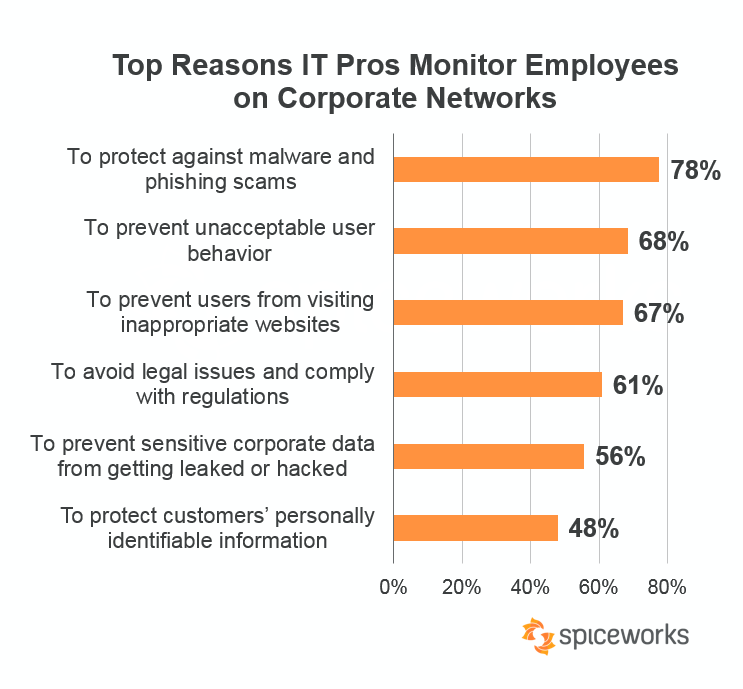
| Employee Monitoring Statistic | Year | Source |
|---|---|---|
| When a group of Canadian employees were asked what the benefits of employee monitoring were: ● 39% said it gave their employers more insight into daily business operations ● 38% said it can ensure staff are never underpaid ● 37% said it allowed mistakes to be caught before they can escalate ● 35% said it gave employers greater visibility into high and low work performers ● 34% said it allowed employers to help them work more efficiently during work hours | 2022 | Capterra Canada Workplace Surveillance Survey |
| When a group of Canadian employees were asked why they think their employers used monitoring tools:47% believed it was used to improve productivity25% believed it was to verify employees worked their exact hours13% believed it was to track their workload | 2022 | Capterra Canada Workplace Surveillance Survey |
| 81% of companies that implemented monitoring software saw an increase in employee productivity | 2021 | Digital.com Survey |
| 52% of small business leaders say the primary goal for monitoring employees is monitoring productivity | 2021 | GetApp Survey |
| Among employees whose activity is being monitored, 53% are spending 3 or more hours per day on non-work activities | 2021 | Digital.com Survey |
| 78% of employees browse social media and other non-work websites during work hours | 2021 | Digital.com Survey |
| 52% of employers have caught an employee working a second job while on the clock thanks to employee monitoring software. 60% detected employee absences from workstations. | 2021 | Digital.com Survey |
| 39% of construction employees, 32% of employees in advertising and marketing, 29% of business and finance workers, and 28% of IT employees spend 5 or more hours per day on non-work activities. | 2021 | Digital.com Survey |
| 41% of employees admit their recorded work calls have evidence that could get them fired. Meanwhile, 37% of employers say they have used stored recordings for firings | 2021 | ExpressVPN Survey |
| 88% of employers terminated workers based on what they saw after implementing monitoring software | 2021 | Digital.com Survey |
| 46% of employers say they’ve terminated an employee based on information collected related to their remote work | 2021 | ExpressVPN Survey |
| 73% of employers say stored recordings of staff’s calls, emails, or messages have informed an employee’s performance reviews | 2021 | ExpressVPN Survey |
| 49% of employees pretend to be online while actually doing non-work activities | 2021 | ExpressVPN Survey |
| 68% of organizations feel moderately to extremely vulnerable to insider attacks and affirm that such attacks have become more frequent. | 2020 | 2020 Insider Threat Report – Cybersecurity Insiders |
| Remote employee managers are most concerned about reduced employee productivity (82%), reduced employee focus (82%), lower employee engagement and satisfaction (81%), and whether their remote employees are getting their work done (80%). | 2019 | OwlLabs State of Remote Work Reports 2019 |
| The top reasons why IT departments monitor employees: ● 78% monitor to protect against malware and phishing scams ● 68% monitor to prevent unacceptable user behavior ● 67% monitor to prevent users from visiting inappropriate websites ● 61% avoid legal issues and comply with regulations ● 56% monitor to prevent leakage of sensitive corporate data ● 48% protecting sensitive customer information | 2017 | Spiceworks Workplace Surveillance Data Snapshot |
| 99% of office workers commit actions that dramatically increase the likelihood of a workplace data breach | 2017 | Intermedia’s 2017 Data Vulnerability Report |
Workplace Privacy Statistics
When it comes to being monitored in the workplace many employees have privacy concerns. While many employers expect their employees to only use workplace technology for work purposes, many employees will spend their downtime and lunch breaks taking care of personal tasks.
Monitoring apps can collect potentially sensitive data:
- Keystroke logging devices can capture sensitive electronic communication/Internal communications and passwords
- Productivity software can be used to micromanage or unfairly target employees
- Employers with remote teams may require that remote employees install monitoring software on their personal devices, which may collect data that is highly personal
- In the event of a data breach an employee’s data may be misused by bad actors
When implementing user activity monitoring solutions employers must have adequate administrative and technical safeguards in place to ensure the confidentiality and fair use of employee data.
FREE WHITE PAPER
Best Practices for Monitoring Employees
In today’s privacy-conscious world employers need to monitor employees in a way that is transparent, minimally invasive, and respectful of employee privacy.
Want to use monitoring tools to get instant visibility into employee productivity, engagement, and PC usage? Read this white paper to learn the best practices for monitoring employees in the workplace.
| Employee Monitoring Statistic | Year | Source |
|---|---|---|
| When asked if they thought their company would violate privacy laws to monitor their work, most (60%) believed their employers would respect the laws. A quarter (26%) thought their company might monitor more than they should in some exceptional cases, while only 14% thought their employers would break privacy laws to monitor all employees. | 2022 | Capterra Canada Workplace Surveillance Survey |
| Outside of those who’d signed consent agreements, the following levels of information were reportedly provided by employers to employees being monitored: 24% were verbally informed23% were informed via email16% were not informed at all | 2022 | Capterra Canada Workplace Surveillance Survey |
| Eight in ten (82%) workers now support a legal requirement to consult before introducing monitoring (compared to 75% in 2020) | 2022 | Trades Union Congress Survey |
| Eight in 10 (77%) workers support no monitoring outside working hours, suggesting strong support for a right to disconnect (compared to 72% in 2020) | 2022 | Trades Union Congress Survey |
| 97% of small business leaders at the monitoring companies say employees are aware they are being monitored | 2021 | GetApp Survey |
| 1 in 3 employees have used their work computer for purposes that they’d find embarrassing should their employer find out | 2021 | ExpressVPN Survey |
| 86% of companies using employee monitoring software have informed their employees—14% have not. | 2021 | Digital.com Survey |
| 80% of companies have a written privacy policy that informs users they could be monitored while using corporate networks, devices, and services. Only 11% of companies do not have a privacy policy in place to inform users of monitoring | 2017 | Spiceworks Workplace Surveillance Data Snapshot |
| Over 80% of employers disclose their monitoring practices to employees | 2008 | Journal of Social Sciences Publication |
How Do Employees Feel About Employee Monitoring?
When implementing monitoring tools it’s important to evaluate the pros and cons of employee monitoring.
While major companies understand the value of employee monitoring software, not every employee will agree that monitoring tools will be beneficial.
Employee sentiment ranges from indifference to concerns that employers will focus too much on a minor amount of lost productivity, resulting in higher stress.
These employee monitoring statistics reveal what employees think about employee monitoring.
| Employee Monitoring Statistic | Year | Source |
|---|---|---|
| Most employees surveyed (65%) don’t believe that being monitored would have any impact on the way they work, though 35% disagree (with 16% who think it would make them work harder and 19% who think it would make them work less hard). | 2022 | Capterra Canada Workplace Surveillance Survey |
| 65% of Canadian employees said the implementation of monitoring tools had no perceived effect on the quality of their work environment. | 2022 | Capterra Canada Workplace Surveillance Survey |
| 40% of survey-takers asked to use monitoring software in their workplace accepted it because they felt OK with it, 23% said they felt insecure about not accepting it and a further 18% admit to accepting it out of pressure. | 2022 | Capterra Canada Workplace Surveillance Survey |
| When a group of Canadian employees was asked what the benefits of employee monitoring were: ● 39% said it gave their employers more insight into daily business operations ● 38% said it can ensure staff are never underpaid ● 37% said it allowed mistakes to be caught before they can escalate ● 35% said it gave employers greater visibility into high and low work performers ● 34% said it allowed employers to help them work more efficiently during work hours | 2022 | Capterra Canada Workplace Surveillance Survey |
| When a group of Canadian employees were asked why they think their employers used monitoring tools: ● 47% believed it was used to improve productivity ● 25% believed it was to verify employees worked their exact hours ● 13% believed it was to track their workload | 2022 | Capterra Canada Workplace Surveillance Survey |
| When asked if they thought their company would violate privacy laws to monitor their work, most (60%) believed their employers would respect the laws. A quarter (26%) thought their company might monitor more than they should in some exceptional cases, while only 14% thought their employers would break privacy laws to monitor all employees. | 2022 | Capterra Canada Workplace Surveillance Survey |
| Eight in ten (82%) workers now support a legal requirement to consult before introducing monitoring (compared to 75% in 2020) | 2022 | Trades Union Congress Survey |
| Eight in 10 (77%) workers support no monitoring outside working hours, suggesting strong support for a right to disconnect (compared to 72% in 2020) | 2022 | Trades Union Congress Survey |
| 1 in 6 employees weren’t aware it was possible for employers to monitor their communication and/or online activities | 2021 | ExpressVPN Survey |
| 1 in 3 employees have used their work computer for purposes that they’d find embarrassing should their employer find out | 2021 | ExpressVPN Survey |
| Only 22% of 18- to 34-year-old employees are concerned about their employers having access to personal information and activity from their work computer | 2020 | Clutch.co Survey |
| 72% of workers say their productivity would not be affected if their company used employee monitoring software | 2020 | Clutch.co Survey |
| 60% of employees say that unless carefully regulated, using technology to make decisions about people at work could increase unfair treatment in the workplace | 2020 | Trade Union Congress Survey |
| 64% of employees said that recent scandals over the misuse of data make them concerned that their employee data might be at risk | 2019 | Accenture Survey of C-suite Executives |
| 92% of workers are open to the collection of data on them and their work, but only if it improves their performance or well-being or provides other personal benefits | 2019 | Accenture Survey of C-suite Executives |
| Gartner survey found that in 2018, 30% of employees were comfortable with their employer monitoring their email, compared to only 10% of employees in 2015 | 2018 | Gartner Survey |
| By a two-to-one margin (54% to 24%) a majority of Americans would find the installation of surveillance cameras and corresponding retention of data to be acceptable, while one-fifth (21%) of adults say their consideration of this tradeoff would depend on the circumstances | 2016 | Pew Research Center Survey |
Other Employee Monitoring Statistics
| Employee Monitoring Statistic | Year | Source |
|---|---|---|
| The employee monitoring solution market estimated to reach up to $6.84 billion by 2028 | 2021 | Market Research Future |
| 41% of employees admit their recorded work calls have evidence that could get them fired. Meanwhile, 37% of employers say they have used stored recordings for firings | 2021 | ExpressVPN Survey |
| 88% of employers terminated workers based on what they saw after implementing monitoring software | 2021 | Digital.com Survey |
| 46% of employers say they’ve terminated an employee based on information collected related to their remote work | 2021 | ExpressVPN Survey |
| 73% of employers say stored recordings of staff’s calls, emails, or messages have informed an employee’s performance reviews | 2021 | ExpressVPN Survey |
| The global Remote Employee Monitoring Software Market is forecasted to reach USD 1,396.2 Million by 2027 | 2020 | GlobeNewsWire Report |
| 8 in 10 developers of the most in-demand employee surveillance software incentivize long-term use by offering annual price incentives and lifetime purchasing options | 2020 | Top10VPN Survey |
| Most Common Employee Behaviors Discovered by Monitoring Tools: ● 77% of IT pros said they’ve found users streaming non work-related content ● 76% encountered employees visiting malicious websites ● 67% have found users are engaging in excessive social media usage ● 56% discovered users viewing inappropriate content ● 50% caught employees using unlicensed software or unapproved cloud services ● 40% discovered employees externally sharing sensitive company data ● 30% caught users running bandwidth-hogging and legally questionable torrents. ● 27% observed employees engaging in illegal activities. | 2017 | Spiceworks Workplace Surveillance Data Snapshot |
| In 80% of cases the IT department is the most involved in monitoring employees on corporate networks | 2017 | Spiceworks Workplace Surveillance Data Snapshot |
Employee Monitoring FAQ
What Software Do Companies Use To Monitor Employees?
Companies use a variety of digital tools and methods to monitor their employees. These range from employee monitoring software tools to call center monitoring platforms and even mobile apps that help track an employee’s location for fleet tracking.
Is It Legal to Track Employees?
The legality of employee monitoring varies based on jurisdiction and collective bargaining agreements. There are various state laws and federal laws such as the Electronic Communications Privacy Act and The California Privacy Rights and Enforcement Act of 2020 (CPRA) that regulate an employer’s right to monitor their employees.
When considering the use of employee monitoring tools it’s essential to first consult legal counsel and implement an employee privacy policy that clearly discloses what is being montored, how the data is collected, how it will be used, and how it will be protected.
According to Workplace Fairness, a California-based non-profit focusing on employee rights, employers can legally monitor nearly everything an employee does at work as long as there is a legitimate business interest that doesn’t outweigh the privacy impacts on the employee.Can Employers Use Remote Employee Monitoring Software to Track Work-From-Home Teams?
Monitoring employees who work from home is a common practice among businesses that want to ensure the productivity and security of their hybrid and remote workers. In the majority of cases, workers must be notified in advance that their technology usage will be tracked.
The monitoring software used to manage remote workers will track a number of activities including internet browsing (social media browsing, search history, active/idle time), software usage, and bandwidth consumption.
These tools are used to manage job productivity, ensure that each worker is following the company’s rules, and protect business assets against insider threats.Do Employers Have to Tell Employees They Are Being Monitored?
It depends. While being transparent about employee monitoring is the recommended best practice, giving notice to employees is not always required.
The majority of jurisdictions require each worker to be made aware of their employer’s intent to monitor. Some jurisdictions with greater rules and laws will further dictate that employees must be made explicitly aware of what data is captured, how it will be used (such as productivity management), and who will have access to it.
As a best practice, employees should consider all activity on employer-owned assets to be tracked.Can Employers Monitor Their Employee’s Personal Devices?
It depends. If an employer allows their employees to use their personal devices for work purposes they may require them to install corporate applications that could feasibly capture details such as internet browsing, applications used, geolocation, etc.
That said, from a legal perspective employers are seldom justified in monitoring the computer activity of employee-owned devices.
Furthermore, under the vast majority of circumstances, an employer will not be justified in secretly monitoring their employee’s personal devices. They will be required to notify them through a workplace monitoring policy, acceptable use policy, or similar company policy.
There are times when personal activity may be logged:
– When using employer-owned devices
– When using employer-owned WiFi, VPN, and other network resources
– When participating in a BYOD program where an employee consents to the monitoring
As a best practice, employees should consider all activity on employer-owned assets to be monitored. If participating in a BYOD program they should use a virtual machine or a container to keep all company software and files separate from their personal activity.
Employers should also be mindful of the privacy concerns of monitoring personal devices and severely limit what they track or provide a company-owned device.How Do Employees Fe
Conclusion
Employee monitoring software is an essential tool for reducing productivity losses, understanding software and SaaS usage trends, and protecting sensitive data against insider threats—but they’re not without their considerations.
These employee monitoring statistics demonstrate that employers need to be mindful of misconceptions about monitoring tools that might hurt company culture. Companies can take steps to educate their employees about why employee monitoring is needed, how the data will (and won’t) be used, and the steps the company will take to protect their data.
Employers that want to implement monitoring tools must have a clear understanding of their goals, understand the workplace privacy laws that affect their right to monitor, and provide their employees with due notice of their intent to monitor.
Improve Employee Productivity With
CurrentWare’s Remote Employee Monitoring Software
Ready to get advanced insights into how your employees spend their time? Reach out to the CurrentWare team for a demo of BrowseReporter, CurrentWare’s employee and computer monitoring software.
- Improve Productivity
Track unproductive web browsing and idle time to detect time-wasting - Save Time With Intuitive Reports
User-friendly reports make it easy to understand employee computer activity - Enhance Visibility
See how employees spend their time—even on Terminal Server and Remote Desktop Services!

